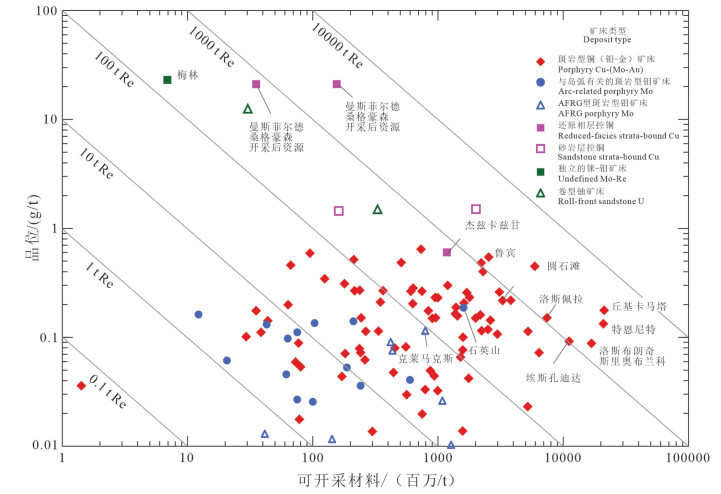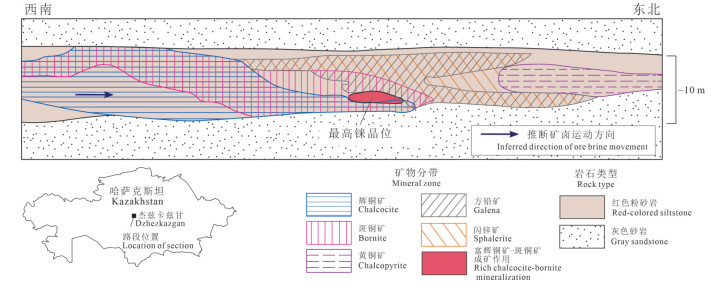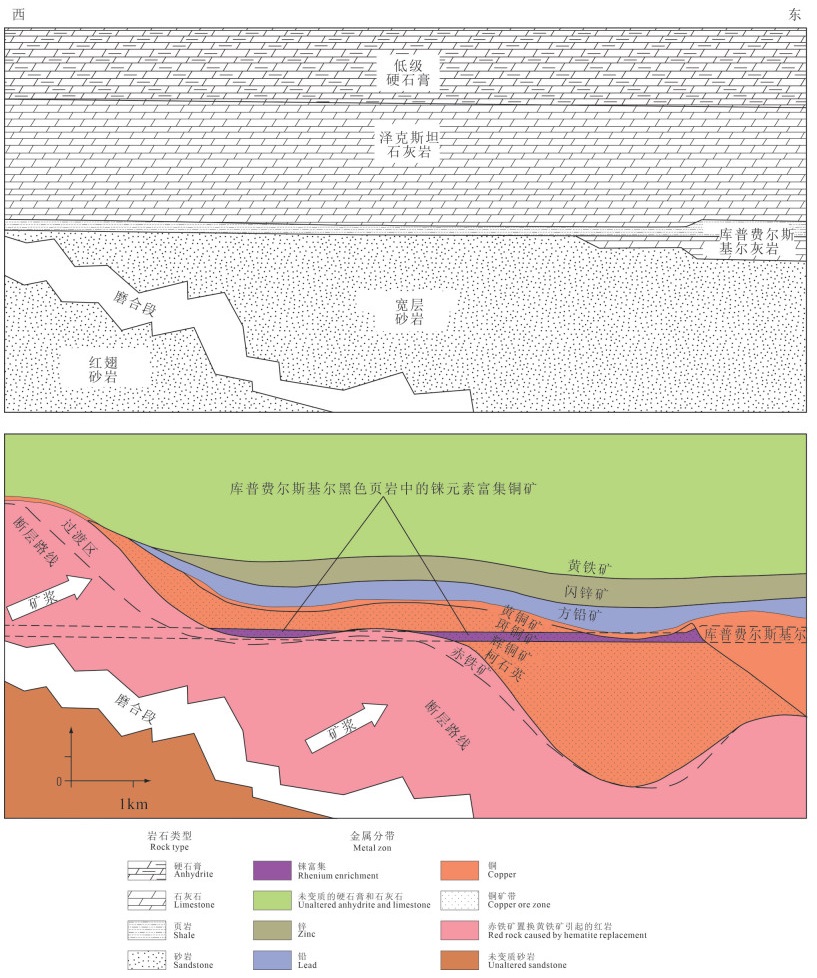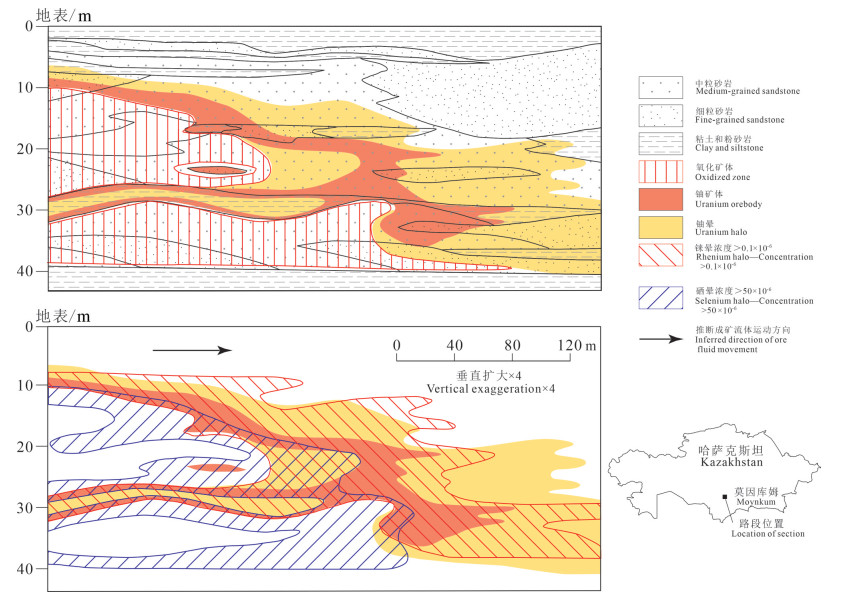The distribution features, main types and present situation of exploration and development for rhenium
-
摘要:
研究目的 全球铼资源分布不均衡,智利占全球铼资源总量的半数以上,其中主要来自于斑岩铜矿床。铼的矿床类型与其赋存状态密切相关,由于铼矿多数与其他矿种伴生,导致铼的矿床类型划分尚未形成统一标准,无法为找矿勘查提供依据,因此急需开展相关研究。
研究方法 本文从全球铼矿赋存状态、矿床成因、矿石类型等方面入手,系统梳理和总结已有典型铼矿的富集成矿规律及矿床类型,以期为该类型矿床的勘探开发提供思路。
研究结果 本文将铼矿床划分为4种类型,即斑岩型铜矿中的铼、沉积层控型铜矿中的铼、砂岩型铀矿中的铼以及矽卡岩型矿床中的铼,其中,以斑岩矿床的铼品位最高、储量最大。铼成矿作用以燕山期最为发育,次为喜马拉雅期、印支期、加里东期,其中,大型伴生铼矿主要发育在加里东期、印支期、燕山期和喜马拉雅期。铼矿勘探方面,已探明铼矿储量的半数以上来自智利,其余主要国家依次为美国、俄罗斯、哈萨克斯坦和亚美尼亚。铼矿开发方面,铼矿很可能存在于大陆弧环境下形成的斑岩型铜矿床,各国开始从斑岩铜矿床中回收铼。
结论 铼矿作为新兴资源,在未来节能减排、碳中和实施方面发挥积极作用,应加强独立铼矿床的勘查以及铜钼铼伴生矿床的成因机制研究,重视老矿山的二次开发利用。
Abstract:This paper is the result of mineral exploration engineering.
Objective The global rhenium resources are unevenly distributed. Chile accounts for more than half of the total global rhenium resources, mainly from porphyry copper deposits. The type of rhenium deposit is closely related to its occurrence state. Since most of the rhenium ore is associated with other minerals, the classification of rhenium deposits has not yet formed a unified standard, which can not provide a basis for ore prospecting. Therefore, it is urgent to carry out relevant research.
Methods In this paper, from the perspective of global occurrence of rhenium deposits, ore types and other aspects, the enrichment and mineralization rules and deposit types of existing typical rhenium deposits are systematically sorted out and summarized, in order to provide ideas for the exploration and development of this type of deposits.
Results Rhenium deposits are divided into four types in this paper: rhenium in porphyry copper deposits, rhenium in sedimentary- type strata- bound copper deposits, rhenium in sandstone- type uranium deposits, and rhenium in skarn deposits. Among them, rhenium in porphyry deposits has the highest grade and largest reserves. In terms of metallogenic characteristics, the Yanshanian period is the most developed for rhenium mineralization, followed by the Himalayan, Indosinian, and Caledonian periods. Large associated rhenium deposits mainly developed in the Caledonian, Indosinian, Yanshanian and Himalayas. In terms of rhenium exploration, more than half of the proven rhenium reserves are from Chile, and the remaining major countries are the United States, Russia, Kazakhstan and Armenia in order. Regarding the development of rhenium ore, rhenium ore is likely to exist in porphyry copper deposits formed in a continental arc environment, and many countries have begun to recover rhenium from porphyry copper deposits.
Conclusions As an emerging resource, rhenium ore will play an active role in the implementation of energy saving, emission reduction, and carbon neutrality in the future. The exploration of independent rhenium deposits and the genetic mechanism of copper-molybdenum- rhenium associated deposits should be strengthened, and the secondary development and utilization of old mines should be emphasized.
-

-
图 1 全球主要铼矿床分布图(据张艳飞等, 2022修改)
Figure 1.
图 2 世界主要含铼矿床的铼品位与矿床吨位图❹(据John and Taylor, 2016修改)
Figure 2.
图 3 宾厄姆的斑岩铜钼金矿(据Landtwing et al., 2010; Seo et al., 2012修改)
Figure 3.
图 4 哈萨克斯坦的砂岩层控型铜矿床❻(据Box et al., 2013修改)
Figure 4.
图 5 还原相(Kupferschiefer)层控型铜矿床❿(据Oszczepalski, 1999修改)
Figure 5.
图 6 哈萨克斯坦楚-萨里苏盆地的Moynkum-Tortkudu地区中的前卷型砂岩铀矿(据Dahlkamp, 2009修改)
Figure 6.
表 1 主要含铼矿床特征(据U.S. Geological Survey, 2014)
Table 1. The characteristics of main rhenium-bearing deposits(after U.S. Geological Survey, 2014)
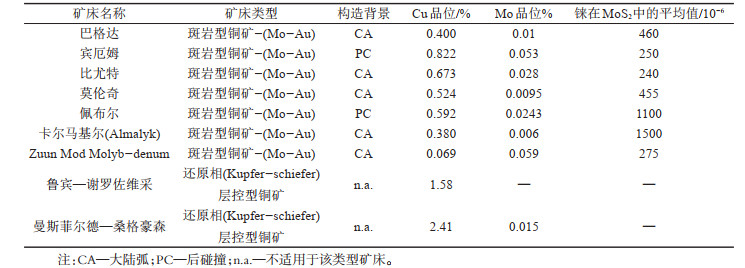
-
Abisheva Z S, Zagorognyaya A N, Bukurov T N. 2001. Recovery of radiogenic 187Os from sulfide copper ores in Kazakhstan[J]. Platinum Metals Review, 45(3): 132-135.
Bai Zhihui, Zhang Jiangfeng. 2019. Brief analysis of the current situation of rhenium standard in China[J]. China Metal Bulletin, (7): 5-6 (in Chinese with English abstract). doi: 10.3969/j.issn.1672-1667.2019.07.003
Box S E, Syusyura B, Seltmann R, Creaser R A, Dolgopolova A, Zientek M L. 2013. Dzhezkazgan and associated sandstone copper deposits of the Chu-Sarysu basin, central Kazakhstan[J]. Society of Economic Geologists, 16: 303-328.
Chen Xifeng, Chen Xiufa, Li Na, Ye Jinhua, Chen Yuming, Zhao Hongjun, Zhang Weibo. 2019. Distribution characteristics and development and utilization status of global rhenium resources and its enlightenments[J]. China Mining Magazine, 28(5): 7-12 (in Chinese with English abstract).
Chen Zhenyan, Li Qingchun, Man Anjing, Chen Xingzhou, Cao Minqiang, Xiong Yaohua, Xiao Cheng. 2021. A uranium-rhenium deposit in superlarge sandstone was found in Kailu Depression[J]. Geotectonica et Metallogenia, 45(2): 425-426 (in Chinese with English abstract).
Dahlkamp F J. 2009. Uranium Deposits of the World-Asia[M]. Berlin: Springer-Verlag, 181-189, 397-400.
Dill H G. 2010. The"chessboard"classification scheme of mineral deposits: Mineralogy and geology from aluminum to zirconium[J]. Earth-Science Reviews, 100(1/4): 1-420.
Duncan R J, Stein H J, Evans K A, Hitzman M W, Nelson E P, Kirwin D J. 2011. A new geochronological framework for mineralization and alteration in the Selwyn-Mount Dore corridor, eastern fold belt, Mount Isa Inlier, Australia-Genetic implications for iron oxide copper-gold deposits[J]. Economic Geology, 106(2): 169-192. doi: 10.2113/econgeo.106.2.169
Emsley J. 2001. Rhenium, in Nature's Building Blocks-An A-Z Guide to The Elements[M]. New York: Oxford University Press, 358-360.
Fleischer M. 1959. The geochemistry of rhenium, with special reference to its occurrence in molybdenite[J]. Economic Geology, 54(8): 1406-1413. doi: 10.2113/gsecongeo.54.8.1406
Guo Juan, Cui Rongguo, Wang Hui, Lin Bolei, Sun Chunqiang, Yang Ling, Zhouzhou. 2020. Supply and demand situation and outlook of global rhenium resources[J]. Land Resources Information, 238(10): 67-74 (in Chinese with English abstract).
Hammer J, Junge F, Rösler H J, Niese S, Gleisberg B, Stiehl G. 1990. Element and isotope geochemical investigations of the Kupferschiefer in the vicinity of"Rote Fäule", indicating copper mineralization (Sangerhausen basin, G.D.R. )[J]. Chemical Geology, 85(3/4): 345-360.
Hao Xuefeng, Peng Yu, Tang Yi, Pan Meng, Liang Bin, Yang Rong, Fan Junbo. 2021. First discovery of sedimentary sandstone-hosted rhenium deposit in the Fetianshan Formation(K1f) in the Puge area, Xichang[J]. Geology in China, 48(6): 197-1977 (in Chinese with English abstract).
Hitzman M, Kirkham R, Broughton D, Thorson J, Selley D. 2005. The sedimenthosted stratiform copper ore system[J]. Economic Geology, 100: 609-642.
Hou Z Q, Zhang H R, Pan X F, Yang Z M. 2011. Porphyry Cu (-MoAu) deposits related to melting of thickened mafic lower crust-Examples from the eastern Tethyan metallogenic domain[J]. Ore Geology Reviews, 39(1/2): 21-45.
Huang Chong, Chen Qishen, Li Ying, Liu Qunyi. 2014. Discussion of world and China rhenium resource demand in 2030[J]. China Mining Magazine, 23(9): 9-12 (in Chinese with English abstract). doi: 10.3969/j.issn.1004-4051.2014.09.003
Huang Fan, Wang Denghong, Wang Yan, Jiang Biao, Li Chao, Zhao Hong. 2019a. Study on metallogenic regularity rhenium deposits in China and their prospecting direction[J]. Acta Geologica Sinica, 93(6): 1252-1269 (in Chinese with English abstract).
Huang Fan, Wu Xishun, Wang Denghong, Sun Yan. 2019b. Ancient and modern"rhenium" -to uncover the supper metal"rhenium" mystery[J]. Land and Resources Science and Culture, 19(2): 10-15(in Chinese with English abstract).
John D A, Taylor R D. 2016. Byproducts of porphyry copper and molybdenum deposits[J]. Reviews in Economic Geology, 18: 137-164.
Khalezov A B. 2009. Problem of rhenium mineral resources expansion in Russian Federation[J]. Razvedka I Okhrana Nedr, 8: 13-17.
Khashgerel B E, Rye O R, Hedenquist J W, Kavalieris I. 2006. Geology and reconnaissance stable isotope study of the Oyu Tolgoi porphyry Cu- Au system, South Gobi, Mongolia[J]. Economic Geology, 101(3): 503-522. doi: 10.2113/gsecongeo.101.3.503
Landtwing M R, Furrer C, Redmond P B, Pettke T, Guillong M, Heinrich C A. 2010. The Bingham Canyon porphyry Cu- Mo-Au deposit. Ⅲ. Zoned copper-gold ore deposition by magmatic vapor expansion[J]. Economic Geology, 105(1): 91-118. doi: 10.2113/gsecongeo.105.1.91
Lang J R, Gregory M J, Rebagliati C M, Payne J G, Oliver J L, Roberts Keith. 2013. Geology and magmatic- hydrothermal evolution of the giant Pebble porphyry copper-gold-molybdenum deposit, southwest Alaska[J]. Economic Geology, 108(3): 437-462. doi: 10.2113/econgeo.108.3.437
Liao Renqiang, Liu He, Li Congying, Sun Weidong. 2020. Rhenium resource exploration prospects in China based on its geochemical properties[J]. Acta Petrologica Sinica, 36(1): 55-67 (in Chinese with English abstract). doi: 10.18654/1000-0569/2020.01.07
Lüschen H, Schnetger B, Brumsack H J, Paul J. 2000. Trace element distribution in Palaeozoic black shales[J]. Journal of Conference Abstracts, 5(2): 656.
Qiao Gengbiao, Ding Jiangang, Su Yonghai, Chen Junlu. 2020. The discovery of Li, Be, Nb, Ta rare metal ore spots in the Bieyesamas area in Altay, Xinjiang[J]. Geology in China, 47(2): 542-543 (in Chinese with English abstract).
Oszczepalski S. 1999. Origin of the Kupferschiefer polymetallic mineralization in Poland[J]. Mineralium Deposita, 34(5): 599-613.
Richards J P. 2009. Postsubduction porphyry Cu- Au and epithermal Au deposits——Products of remelting of subduction modified lithosphere[J]. Geology, 37(3): 247-250. doi: 10.1130/G25451A.1
Rudnick R L, Gao S, Holland H D, Turekian K K. 2003. Composition of the Continental Crust[M]. Oxford: Elsevier-Pergamon, 1-64.
Ruiz J, Mathur R. 1999. Metallogenesis in continental margins——Re-Os evidence from porphyry copper deposits in Chile[J]. Reviews in Economic Geology Series, 12(3): 59-72.
Selby D, Kelley K D, Hitzman M W, Zieg J. 2009. Re-Os sulfide(bornite, chalcopyrite and pyrite) systematics of the carbonatehosted copper deposits at Ruby Creek, southern Brooks Range, Alaska[J]. Economic Geology, 104(3): 437-444. doi: 10.2113/gsecongeo.104.3.437
Seo J H, Guillong M, Heinrich C A. 2012. Separation of molybdenum and copper in porphyry deposits——The roles of sulfur, redox, and pH in ore mineral deposition at Bingham Canyon[J]. Economic Geology, 107(2): 333-356. doi: 10.2113/econgeo.107.2.333
Sillitoe R H. 2010. Porphyry copper systems[J]. Economic Geology, 105(1): 3-41. doi: 10.2113/gsecongeo.105.1.3
Sun W D, Bennett V C, Eggins S M, Kamenetsky V S, Arculus R J. 2003. Enhanced mantle-to-crust rhenium transfer in undegassed arc magmas[J]. Nature, 422(3): 294-297.
Taylor S R, McLennan S M. 1995. The geochemical evolution of the continental crust[J]. Reviews of Geophysics, 33(2): 241-265. doi: 10.1029/95RG00262
U.S. Geological Survey. 2014. Mineral Resources Data System[M]. U.S. Geological Survey database.
U.S. Geological Survey. 2020. Mineral Resources Data System[M]. U.S. Geological Survey database.
Wang Haiyong, He Liang. 2018. Talking about the enrichment law and comprehensive utilization of rhenium[J]. China Resources Comprehensive Utilization, 36(11): 70-72 (in Chinese with English abstract).
Wu Xian, Li Laiping, Zhang Wenzheng, Zhang Xin. 2008. Properties of rhenium and distribution of rhenium resources[J]. Express Information of Mining Industry, 475(11): 67-69 (in Chinese with English abstract).
Vaughan D J, Sweeney M A, Friedrich G, Diedel R, Haranczyk C. 1989. The Kupferschiefer——An overview with an appraisal of the different types of mineralization[J]. Economic Geology, 84(5): 1003-1027. doi: 10.2113/gsecongeo.84.5.1003
Yang Minzhi. 2000. Types of dispered element deposits, metallogenic regularity and metallogenic prediction[J]. Bulletin of Mineralogy Petrology and Geochemistry, 19(4): 381-383 (in Chinese). doi: 10.3969/j.issn.1007-2802.2000.04.064
Zhang Sen, Shi Lei, Ju Nan, Su Jianwei. 2018. The"oil-uranium coexploration"idea in Songliao basin: a practice in the Southern Central Depression[J]. Geology and Resource, 27(3): 257-262 (in Chinese with English abstract).
Zhang Yanfei, An Zhengzhen, Liang Shuai, Zhai Furong, Zhang Sen, Ju Nan, Jiang Ping, Jin Xiuying, Xiao Rongge. 2022. Distribution characteristics, genetic types and prospecting progress of graphite deposits[J]. Geology in China, 49(1): 135-150 (in Chinese with English abstract).
白智辉, 张江峰. 2019. 我国铼标准现状简析[J]. 中国金属通报, (7): 5-6. https://www.cnki.com.cn/Article/CJFDTOTAL-JSTB201907004.htm
陈喜峰, 陈秀法, 李娜, 叶锦华, 陈玉明, 赵宏军, 张伟波. 2019. 全球铼矿资源分布特征与开发利用形势及启示[J]. 中国矿业, 28(5): 7-12, 23. https://www.cnki.com.cn/Article/CJFDTOTAL-ZGKA201905002.htm
陈振岩, 李清春, 满安静, 陈星州, 曹民强, 熊耀华, 肖程. 2021. 开鲁坳陷发现特大型砂岩铀铼共(伴)生矿床[J]. 大地构造与成矿学, 45(2): 425-426. https://www.cnki.com.cn/Article/CJFDTOTAL-DGYK202102013.htm
郭娟, 崔荣国, 王卉, 林博磊, 孙春强, 杨玲, 周舟. 2020. 世界铼资源供需现状及展望[J]. 国土资源情报, 238(10): 67-74, 66. https://www.cnki.com.cn/Article/CJFDTOTAL-GTZQ202010012.htm
郝雪峰, 彭宇, 唐屹, 潘蒙, 梁斌, 杨荣, 范俊波. 2021. 西昌普格地区飞天山组(K1f)中首次发现沉积砂岩型铼矿[J]. 中国地质, 48(6): 1975-1977. http://geochina.cgs.gov.cn/geochina/article/abstract/20210623?st=search
黄翀, 陈其慎, 李颖, 柳群义. 2014. 2030年全球及中国铼资源需求刍议[J]. 中国矿业, 23(9): 9-11, 29. https://www.cnki.com.cn/Article/CJFDTOTAL-ZGKA201409003.htm
黄凡, 王登红, 王岩, 江彪, 李超, 赵鸿. 2019a. 中国铼矿成矿规律和找矿方向研究[J]. 地质学报, 93(6): 1252-1269. https://www.cnki.com.cn/Article/CJFDTOTAL-DZXE201906007.htm
黄凡, 吴西顺, 王登红, 孙艳. 2019b. 古往今"铼" 以小博大——揭开超级金属"铼" 的神秘面纱[J]. 国土资源科普与文化: 19(2): 10-15. https://www.cnki.com.cn/Article/CJFDTOTAL-GTKW201902005.htm
廖仁强, 刘鹤, 李聪颖, 孙卫东. 2020. 从铼的地球化学性质看我国铼找矿前景[J]. 岩石学报, 36(1): 55-67. https://www.cnki.com.cn/Article/CJFDTOTAL-YSXB202001007.htm
乔耿彪, 丁建刚, 苏永海, 陈隽璐. 2020. 新疆阿尔泰山别也萨麻斯一带发现新的锂、铍、铌、钽等稀有金属矿点[J]. 中国地质, 47(2): 542-543. http://geochina.cgs.gov.cn/geochina/article/abstract/20200221?st=search
王海勇, 何亮. 2018. 浅谈铼的富集规律和综合利用[J]. 中国资源综合利用, 36(11): 70-72. https://www.cnki.com.cn/Article/CJFDTOTAL-ZWZS201811023.htm
吴贤, 李来平, 张文钲, 张新. 2008. 铼的性质及铼资源分布[J]. 矿业快报, 475(11): 67-69. https://www.cnki.com.cn/Article/CJFDTOTAL-KYKB200811027.htm
杨敏之. 2000. 分散元素矿床类型、成矿规律及成矿预测[J]. 矿物岩石地球化学通报, (4): 381-383. https://www.cnki.com.cn/Article/CJFDTOTAL-KYDH200004063.htm
张艳飞, 安政臻, 梁帅, 翟富荣, 张森, 鞠楠, 姜平, 金秀英, 肖荣阁. 2022. 石墨矿床分布特征、成因类型及勘查进展[J]. 中国地质, 49(1): 135-150. http://geochina.cgs.gov.cn/geochina/article/abstract/20220109?st=search
张森, 石蕾, 鞠楠, 苏建伟. 2018. "油铀兼探" 的找矿思路在松辽盆地的应用——以中央拗陷区南部为例[J]. 地质与资源, 27(3): 257-262. https://www.cnki.com.cn/Article/CJFDTOTAL-GJSD201803007.htm
-



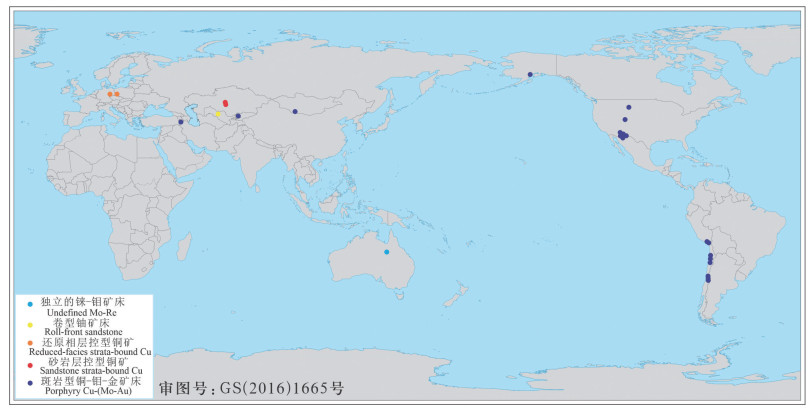
 下载:
下载:
